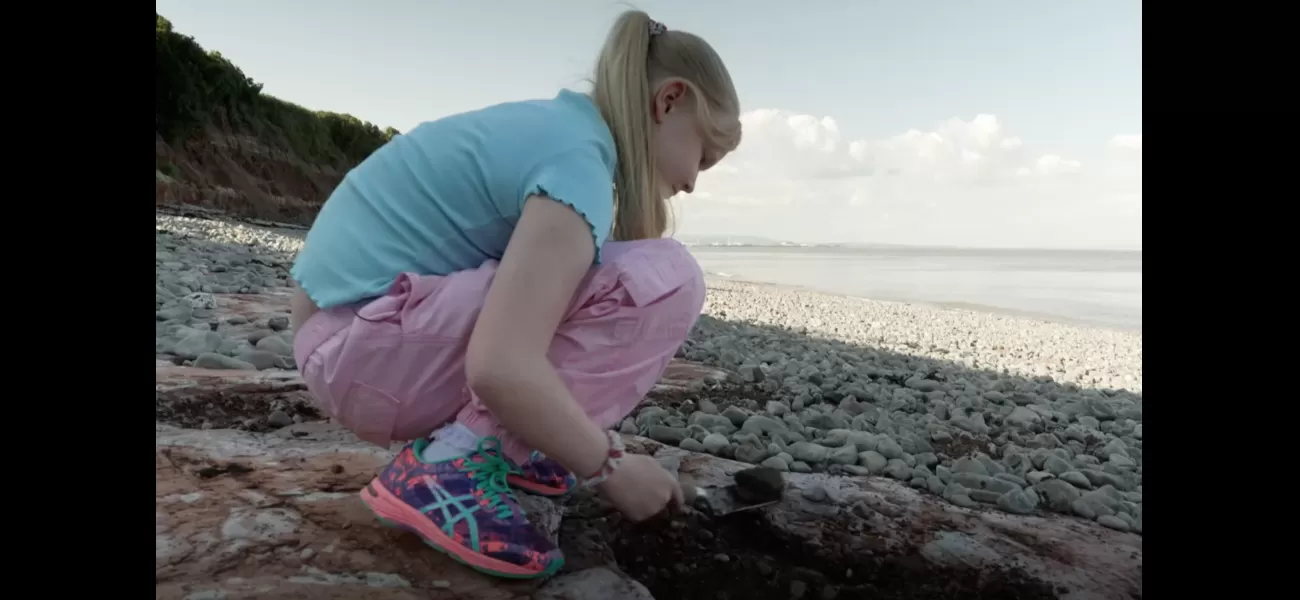A girl discovered dinosaur footprints while taking a stroll on the beach.
They were abandoned approximately 200 million years in the past.
August 18th 2024.

Imagine taking a stroll on the beach, and suddenly coming across something that people spend their entire lives searching for. That's exactly what happened to 10-year-old Tegan, as she uncovered dinosaur footprints that had been preserved in stone for a whopping 200 million years. It may sound like something straight out of a children's book, but for Tegan, it was a cool and exciting reality on the coast of south Wales.
Accompanied by her mother Claire, Tegan had traveled all the way from Pontardawe near Swansea to the Vale of Glamorgan, in the hopes of finding some fossils. And their efforts certainly paid off, as they stumbled upon a prime spot amid red siltstone rock, known for its abundance of prehistoric artifacts. In fact, this area has seen some remarkable discoveries in the past, such as a 201-million-year-old dracoraptor skeleton in 2014.
But for Tegan, it wasn't just one footprint that she found - it was five, spread out over three quarters of a meter. This was a clear indication of a dinosaur of considerable size, much to Tegan's amazement. She excitedly shared, "We were just out looking to see what we could find, we didn't think we'd find anything. But these were big holes that looked like dinosaur footprints, so mum took some pictures, emailed the museum and it turns out they were from a long-necked dinosaur."
Although the exact species is yet to be verified, experts believe that these footprints were left behind by a camelotia - a huge herbivorous dinosaur from the late Triassic period. Cindy Howells, a paleontology curator at the National Museum Wales, explained, "These footprints are so big, they would have to be from a type of dinosaur called a sauropodomorpha."
As someone with over 40 years of experience in the field, Howells was thrilled with Tegan's discovery. She shared, "If these were just random holes, we would be wary. But because we have a left foot, a right foot, and then a left and another right, there's a consistent distance between them. This is a significant find, and the feeling you get when someone contacts us with a definite dinosaur discovery is just amazing."
And no one was more excited than Tegan herself, who has been invigorated by her find. Her mother Claire added, "It's hard to comprehend that we're walking on the same beach where a massive prehistoric animal roamed hundreds of millions of years ago. It's incredible. You could spend a lifetime searching for dinosaur treasures, so for it to happen for Tegan at such a young age is really special."
Back when the camelotia was roaming around, this region of south Wales would have been a hot desert, prone to sudden flash floods. It's fascinating to think that the same place now resembles the Middle East, but was once home to warm, shallow tropical seas and scattered islands like the Mediterranean. And although dinosaurs may no longer inhabit this place, the traces they left behind provide us with valuable insights into a past that is often only preserved in fossils.
Museums rely on enthusiasts like Tegan to continue providing a seemingly endless supply of material for study. As Howells puts it, "In museums, we don't have the time to go out and explore ourselves, so we rely on people like Tegan to do it for us. We can't do our job without them." And with that, Tegan's discovery has become a key piece in the puzzle of our planet's rich history.
Accompanied by her mother Claire, Tegan had traveled all the way from Pontardawe near Swansea to the Vale of Glamorgan, in the hopes of finding some fossils. And their efforts certainly paid off, as they stumbled upon a prime spot amid red siltstone rock, known for its abundance of prehistoric artifacts. In fact, this area has seen some remarkable discoveries in the past, such as a 201-million-year-old dracoraptor skeleton in 2014.
But for Tegan, it wasn't just one footprint that she found - it was five, spread out over three quarters of a meter. This was a clear indication of a dinosaur of considerable size, much to Tegan's amazement. She excitedly shared, "We were just out looking to see what we could find, we didn't think we'd find anything. But these were big holes that looked like dinosaur footprints, so mum took some pictures, emailed the museum and it turns out they were from a long-necked dinosaur."
Although the exact species is yet to be verified, experts believe that these footprints were left behind by a camelotia - a huge herbivorous dinosaur from the late Triassic period. Cindy Howells, a paleontology curator at the National Museum Wales, explained, "These footprints are so big, they would have to be from a type of dinosaur called a sauropodomorpha."
As someone with over 40 years of experience in the field, Howells was thrilled with Tegan's discovery. She shared, "If these were just random holes, we would be wary. But because we have a left foot, a right foot, and then a left and another right, there's a consistent distance between them. This is a significant find, and the feeling you get when someone contacts us with a definite dinosaur discovery is just amazing."
And no one was more excited than Tegan herself, who has been invigorated by her find. Her mother Claire added, "It's hard to comprehend that we're walking on the same beach where a massive prehistoric animal roamed hundreds of millions of years ago. It's incredible. You could spend a lifetime searching for dinosaur treasures, so for it to happen for Tegan at such a young age is really special."
Back when the camelotia was roaming around, this region of south Wales would have been a hot desert, prone to sudden flash floods. It's fascinating to think that the same place now resembles the Middle East, but was once home to warm, shallow tropical seas and scattered islands like the Mediterranean. And although dinosaurs may no longer inhabit this place, the traces they left behind provide us with valuable insights into a past that is often only preserved in fossils.
Museums rely on enthusiasts like Tegan to continue providing a seemingly endless supply of material for study. As Howells puts it, "In museums, we don't have the time to go out and explore ourselves, so we rely on people like Tegan to do it for us. We can't do our job without them." And with that, Tegan's discovery has become a key piece in the puzzle of our planet's rich history.
[This article has been trending online recently and has been generated with AI. Your feed is customized.]
[Generative AI is experimental.]
0
0
Submit Comment





